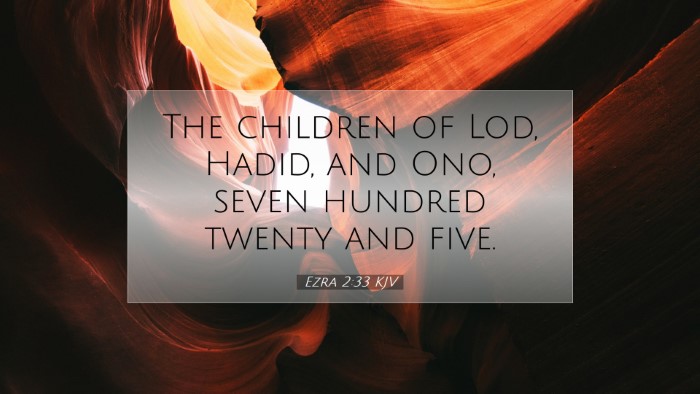Commentary on Ezra 2:33
Ezra 2:33 states: "The children of Adin, four hundred fifty and four." This verse is part of a broader list identifying the returning exiles from Babylon to Jerusalem, and it highlights the lineage of the people returning to Zion.
Contextual Overview
The book of Ezra portrays the return of the Jewish exiles and the restoration of worship in Jerusalem. Ezra 2 forms a vital part of this narrative, revealing the demographic and genealogical significance of those who returned. The passage provided, while specific in its numerical detail, should be examined within the larger framework of Israel's restoration.
The Significance of Genealogy
The mention of "the children of Adin" followed by their count is not merely numerical. Each name and number signifies:
- A Restoration of Identity: The returnees were restoring their Jewish identity, which formed a critical part of their covenant relationship with God.
- A Fulfillment of Prophecy: The return from exile was a fulfillment of the prophecies made through Jeremiah and other prophets, affirming God’s faithfulness.
- Community and Structure: The genealogy reflects the structure of the community being rebuilt, indicating a re-establishment of families and social order.
Insights from Matthew Henry
Matthew Henry emphasizes the importance of every individual represented in these genealogies. He notes that even a small group, like Adin's children, plays a critical role in the narrative of redemption. Every returnee had a purpose in God’s plan, reflecting God’s attention to detail in His covenant community.
Insights from Albert Barnes
Albert Barnes, in his commentary, draws attention to the number of returned exiles. He suggests that while 454 individuals may seem insignificant, such numbers were vital for the rebuilding of the Jewish community. Each family unit contributes to the continuity of faith and worship. Barnes also indicates the possible challenges these families faced in restoring their lives in a renewed Jerusalem environment.
Insights from Adam Clarke
Adam Clarke adds depth by pointing out that Adin was a notable family that had stood strong during the Babylonian captivity. Clarke places emphasis on the historical legacy and the honor associated with the family name. He notes that these individuals were not just returning as a number; rather, they were carrying the historical burden of their ancestry and a great expectation to restore their heritage.
Theological Implications
Ezra 2:33 carries significant implications for theology and ministry:
- God’s Sovereignty: The return of the exiles illustrates God's sovereign orchestration of events and His faithfulness to His people.
- The Value of Community: The returning families reinforce the idea that God’s work is accomplished through communities. The rebuilding of Jerusalem was not only a physical task but also a social and spiritual one.
- Identity in Christ: For modern believers, the concept of returning and restoration translates into the New Testament promise of being rooted in Christ, where all believers form a part of the body of Christ.
Applications for Pastoral Ministry
For pastors and ministry leaders, the commentary on Ezra 2:33 offers practical insights:
- Recognizing Individuals: In our congregations, it is essential to recognize each member's contributions to the church’s mission, emphasizing that every person counts.
- Emphasizing History: Understanding and teaching church history and the rich heritage of faith can strengthen the sense of identity among the congregation.
- Encouragement in Restoration: Just as the exiles returned to restore their lives, ministers should inspire their congregants that restoration is possible, presenting a God who restores and redeems.
Conclusion
In summary, Ezra 2:33, while concise in its account of the number of Adin’s children, serves as a crucial reminder of God's faithfulness to His people, the importance of community, and the identity that believers hold in Christ. The insights from revered commentaries like those of Henry, Barnes, and Clarke enrich our understanding and application of this scripture, encouraging deeper reflection within pastoral and scholarly contexts.


